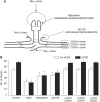A novel fragment derived from the beta chain of human fibrinogen, beta43-63, is a potent inhibitor of activated endothelial cells in vitro and in vivo
- PMID: 20068569
- PMCID: PMC2822935
- DOI: 10.1038/sj.bjc.6605495
A novel fragment derived from the beta chain of human fibrinogen, beta43-63, is a potent inhibitor of activated endothelial cells in vitro and in vivo
Abstract
Background: Angiogenesis and haemostasis are closely linked within tumours with many haemostatic proteins regulating tumour angiogenesis. Indeed we previously identified a fragment of human fibrinogen, fibrinogen E-fragment (FgnE) with potent anti-angiogenic properties in vitro and cytotoxic effects on tumour vessels in vivo. We therefore investigated which region of FgnE was mediating vessel cytotoxicity.
Methods: Human dermal microvascular endothelial cells (ECs) were used to test the efficacy of peptides derived from FgnE on proliferation, migration, differentiation, apoptosis and adhesion before testing the efficacy of an active peptide on tumour vasculature in vivo.
Results: We identified a 20-amino-acid peptide derived from the beta chain of FgnE, beta43-63, which had no effect on EC proliferation or migration but markedly inhibited the ability of activated ECs to form tubules or to adhere to various constituents of the extracellular matrix - collagen IV, fibronectin and vitronectin. Furthermore, our data show that beta43-63 interacts with ECs, in part, by binding to alpha(v)beta(3), so soluble alpha(v)beta(3) abrogated beta43-63 inhibition of tubule formation by activated ECs. Finally, when injected into mice bearing tumour xenografts, beta43-63 inhibited tumour vascularisation and induced formation of significant tumour necrosis.
Conclusions: Taken together, these data suggest that beta43-63 is a novel anti-tumour peptide whose anti-angiogenic effects are mediated by alpha(v)beta(3).
Figures





Similar articles
-
Alphastatin, a 24-amino acid fragment of human fibrinogen, is a potent new inhibitor of activated endothelial cells in vitro and in vivo.Blood. 2004 Jan 15;103(2):601-6. doi: 10.1182/blood-2003-07-2192. Epub 2003 Sep 25. Blood. 2004. PMID: 14512300
-
The COOH-terminal globular domain of fibrinogen gamma chain suppresses angiogenesis and tumor growth.Cancer Res. 2006 Oct 1;66(19):9691-7. doi: 10.1158/0008-5472.CAN-06-1686. Cancer Res. 2006. PMID: 17018627
-
Peptides derived from human decorin leucine-rich repeat 5 inhibit angiogenesis.J Biol Chem. 2005 Jul 29;280(30):27935-48. doi: 10.1074/jbc.M414320200. Epub 2005 May 27. J Biol Chem. 2005. PMID: 15923192
-
Inhibition of angiogenesis in vitro and in vivo: comparison of the relative activities of triflavin, an Arg-Gly-Asp-containing peptide and anti-alpha(v)beta3 integrin monoclonal antibody.Biochim Biophys Acta. 1997 Oct 20;1336(3):445-54. doi: 10.1016/s0304-4165(97)00057-3. Biochim Biophys Acta. 1997. PMID: 9367172
-
The role of fibrinogen and related fragments in tumour angiogenesis and metastasis.Expert Opin Biol Ther. 2003 Oct;3(7):1105-20. doi: 10.1517/14712598.3.7.1105. Expert Opin Biol Ther. 2003. PMID: 14519075 Review.
Cited by
-
Erythroid-transdifferentiated myeloid cells promote portal vein tumor thrombus in hepatocellular carcinoma.Theranostics. 2023 Jul 31;13(13):4316-4332. doi: 10.7150/thno.82907. eCollection 2023. Theranostics. 2023. PMID: 37649603 Free PMC article.
-
Novel aspects of fibrin(ogen) fragments during inflammation.Mol Med. 2011 May-Jun;17(5-6):568-73. doi: 10.2119/molmed.2010.00146. Epub 2011 Jan 4. Mol Med. 2011. PMID: 21210072 Free PMC article. Review.
-
Anti-angiogenic peptides for cancer therapeutics.Curr Pharm Biotechnol. 2011 Aug;12(8):1101-16. doi: 10.2174/138920111796117300. Curr Pharm Biotechnol. 2011. PMID: 21470139 Free PMC article. Review.
-
Fibrinogen and tumors.Front Oncol. 2024 May 8;14:1393599. doi: 10.3389/fonc.2024.1393599. eCollection 2024. Front Oncol. 2024. PMID: 38779081 Free PMC article. Review.
-
The intratumoral microbiota heterogenicity is related to the prognosis and tumorigenesis of cervical cancer.Front Cell Infect Microbiol. 2025 May 13;15:1574511. doi: 10.3389/fcimb.2025.1574511. eCollection 2025. Front Cell Infect Microbiol. 2025. PMID: 40433663 Free PMC article.
References
-
- Beckstead J (1994) A simple technique for preservation of fixation sensitive antigens in paraffin-embedded tissues. J Histochem Cytochem 42: 1127–1134 - PubMed
-
- Bootle-Wilbraham CA, Tazzyman S, Marshall JM, Lewis CE (2000) Fibrinogen E-fragment inhibits the migration and tubule formation of human dermal microvascular endothelial cells in vitro. Cancer Res 60: 4719–4724 - PubMed
-
- Borges E, Jan Y, Ruoslahti E (2000) Platelet derived growth factor receptor beta and vascular endothelial growth factor receptor 2 bind to the beta 3 integrin through its extracellular domain. J Biol Chem 275: 39867–39873 - PubMed
-
- Chua CC, Rahimi N, Forsten-Williams K, Nugent MA (2004) Heparan sulfate proteoglycans function as receptors for fibroblast growth factor-2 activation of extracellular signal-regulated kinases 1 and 2. Circ Res 94: 316–323 - PubMed
Publication types
MeSH terms
Substances
LinkOut - more resources
Full Text Sources

